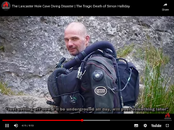- Messages
- 53,669
- Reaction score
- 7,843
- # of dives
- 500 - 999
A fell (from Old Norse fell, fjall, "mountain"[1]) is a high and barren landscape feature, such as a mountain range or moor-covered hills. See Fell - Wikipedia
A force spokesman added: "The man in his 60s, who is believed to be from the Lancashire area, was visiting Casterton Fell on a cave diving trip. See BBC story at Man found dead in flooded cave
The Ease Gill Cave System is the longest,[1] and most complex cave system in Britain as of 2011,[2][3][4][5] with around 41 miles (66 km) of passages, including connections only passable by cave diving. It spans the valley between Leck Fell and Casterton Fell. The water resurges into Leck Beck. From Ease Gill Caverns - Wikipedia
Detailed report from Cave Rescue Organisation
Lancaster Hole, Casterton Fell, Cumbria - Cave Incident.
The Cave Rescue Organisation (CRO) were called by Cumbria Police at 1656 hrs on Saturday 4th January 2020 to reports of an overdue cave diver at Lancaster Hole on Casterton Fell, Cumbria.
40 CRO team members and members of the Northern section of the Cave Diving Group (CDG) responded. As well as searching from the point where the cave diver entered Lancaster Hole downstream passage (1), other entrances and possible exits were also searched by team members and a cave diver, in case the diver had emerged from the system elsewhere.
The initial search from the access point was led by another member of the Cave Diving Group, who planned to search the first section of the downstream passage. Other CDG members were preparing to conduct an extended search if this initial search did not locate the casualty.
Unfortunately, whilst conducting his underwater search the rescue diver discovered the missing diver, approximately 60 metres into the sump (2). The casualty was immediately brought back to the sump pool chamber and removed from the water, where it was apparent that he was deceased.
All team members were then instrumental in conducting a lengthy and difficult extraction back to the surface of the fell. The casualty was then conveyed to Bull Pot Farm and handed over to the care of Cumbria Police.
Details of the casualty will be made available by Cumbria Police in due course, but we would like to stress that although the casualty was known to team members, he was not a member of any rescue team or the Cave Diving rescue group. Investigations into the cause of the incident are currently underway on behalf of the Coroner by Cumbria Police.
Notes
1 Lancaster Hole downstream passage is a long, submerged stretch of cave which in wet weather floods many normally drier sections of cave above. It is being actively explored by cave divers who are extending the explored section, currently some 900 metres beyond the sump pool where access to the flooded section is normally made.
2 A sump, or siphon, is a passage in a cave that is submerged under water. A sump may be static, with no inward or outward flow, or active, with continuous through-flow. Static sumps may also be connected underwater to active stream passage.





